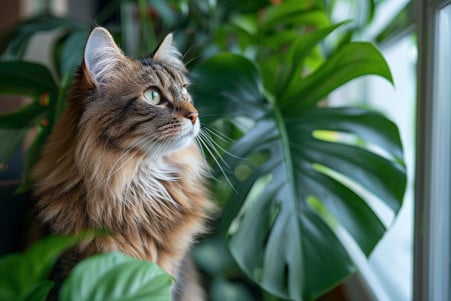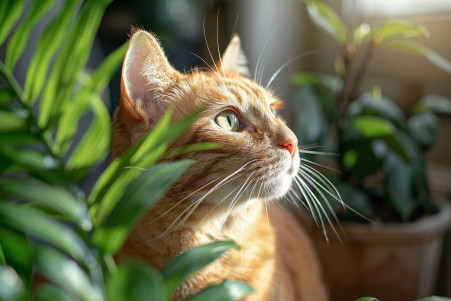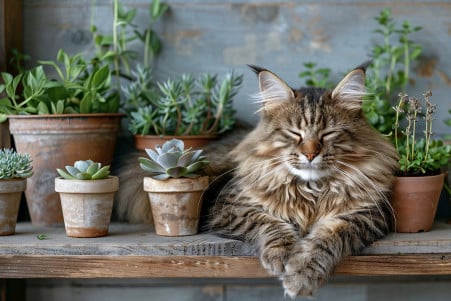Can Cats Eat Money Trees? A Guide to Pet Safety
13 February 2024 • Updated 12 February 2024

If you’re a pet owner, you’ve probably worried about the potential dangers that certain houseplants might pose to your cat. While money trees, or Pachira aquatica, are safe for cats, as with any plant, eating too much of it can lead to some minor tummy troubles. To avoid any potential digestive issues for your cat, it’s best to put them in a place that’s not easily accessible.
Now that we’ve determined that money trees are safe for cats, we’ll take a look at a number of studies and expert opinions in the fields of veterinary science and pet care.
We’ll investigate the ways in which different plants can impact the health and behavior of cats, and we’ll also discuss how you can make sure your cats and your plants can coexist.
By examining the research of animal behaviorists and plant professionals, we hope to offer a comprehensive view that will help you ensure that your cats and your houseplants can coexist in perfect accord.
Are money trees toxic to cats?
Money Trees and Cats: Are They Safe or Toxic?
Money trees are popular among indoor gardeners for their braided trunks and bright, green foliage. Their good looks, supposed feng shui benefits, resilience, and low-maintenance care requirements make them especially sought after.
Concerns about the potential toxicity of indoor plants, especially to cats, are common among pet owners. Luckily, the American Society for the Prevention of Cruelty to Animals (ASPCA) has confirmed that money trees are non-toxic to cats, dogs, and horses, so there’s no need to worry about serious health issues.
That said, cats’ natural curiosity may still lead them to investigate money trees, which can result in chewing or eating the plant. This may lead to mild stomach upset, including vomiting and diarrhea. Cat parents can take steps to avoid this by keeping plants in areas that are hard for cats to access or using natural deterrents.
That said, knowing the signs of plant-related stomach upset can help you ensure that your cat gets the care they need, even if they’ve ingested a non-toxic plant.
Knowing how to spot and address any unexpected nibbling is important for keeping your home safe for your pets and your plants. Make sure to stay informed and be watchful to ensure that your furry friends stay healthy and happy.
Taking Care of Your Money Tree: Tips for Growth and Pet Safety
Since money trees are native to tropical environments, they need to be kept in similar conditions. This means that bright, indirect light is best, and you should avoid direct sunlight to prevent leaf burn. Keeping the temperature between 65–80°F and using well-draining soil will also help your money tree grow.
Water your money tree when the soil becomes dry to the touch, but be careful not to overwater, as this is the most serious threat to your money tree and can lead to root rot. Let the top couple of inches of soil dry out before watering again.
If you fertilize your money tree, make sure to use a balanced, half-strength fertilizer and avoid over-fertilizing, which can be harmful to both your plant and your cat.
You should also keep an eye out for common houseplant pests like spider mites and mealybugs. If you need to treat your money tree for pests, make sure to use pet-safe pest control options like neem oil or insecticidal soap, which won’t introduce harmful chemicals that could be dangerous to your cat.
Following these care tips—providing the right light, temperature, and water and using pet-safe plant care products—will help your money tree thrive and keep your pets safe. In addition, providing proper care for your plants will help you create a healthy and stimulating home environment that’s less likely to entice your cat to cause trouble.
Why Do Cats Eat Money Trees?
Cats are naturally curious animals and this curiosity can lead them to chew on houseplants, including money trees. According to Vetstreet, cats are likely to explore their environment, and that includes tasting the plants they find. Some researchers believe that cats eat plants to fulfill specific dietary needs, like getting fiber to aid digestion or to help them vomit and get rid of something that’s making them feel sick.
While money trees are non-toxic, Preventive Vet warns that cats can still experience gastrointestinal upset if they eat too much plant material. This is why it’s important to note the difference between non-toxic and safe; just because a plant won’t poison your cat doesn’t mean it’s safe for them to eat in large quantities.
To help prevent any problems, CatHealth.com recommends keeping houseplants out of your cat’s reach and providing “kitty grass” as a safe alternative for them to chew on.
To discourage your cat from eating your plants, you can also use deterrents like bitter sprays and make sure your cat has plenty of environmental enrichment. Playing with your cat and providing them with toys, scratching posts, and other interactive toys can help them fulfill their natural instincts in a way that’s safe and healthy, which can help create a better environment for your cat and your beloved houseplants.
How to Tell If Your Cat Is Poisoned
While money trees are nontoxic to cats, it’s important to know the signs of plant poisoning because they can vary from mild to life-threatening. According to PetMD, common signs of plant poisoning include vomiting, diarrhea, skin or mouth irritation, and difficulty breathing. On the other hand, mild gastrointestinal upset from nontoxic plants will typically only cause mild symptoms like vomiting or diarrhea without any other symptoms.
If you notice clinical signs like drooling, changes in urine or thirst, lethargy, tremors, or seizures in your cat, which are listed by Dr. Stephanie Austin on Preventive Vet, it could be a sign that your cat has ingested a toxic plant.
It’s important to act quickly. Remove any plant material from your cat’s vicinity, put your cat in a safe area, and contact a veterinarian or a poison control hotline like the ASPCA’s Animal Poison Control.
To keep your home safe for your pets, it’s important to know and understand the potential dangers of all the plants in your home. International Cat Care suggests removing toxic plants, especially for kittens and indoor cats, and stresses the importance of awareness and education in preventing accidental poisoning.
By staying ahead of the game and learning about the plants in your home, you can help ensure that your cat has a long, healthy life in a safe, green environment.
Creating a Safe Space: Cat-Safe Indoor Gardens
One of the most enjoyable ways to make your cat’s environment more stimulating is to create an indoor garden that’s safe for your pet. The ASPCA recommends Areca Palms, Boston Ferns, and Orchids as examples of non-toxic plants that can be used in a pet-friendly indoor garden.
When creating your indoor garden, try to put your plants in high places so that they’re out of your cat’s reach, and you’ll be able to make sure your home is both stylish and safe for your pet.
If you want to protect your houseplants, like money trees, from your cat, you can use plant stands and hanging planters. You can also use protective grates and sprays that taste bitter to cats to keep them away from your plants.
A post by Barkley and Paws also suggests that you can protect your plants by giving your cat their own plants to chew on, like cat grass, which will satisfy their natural urge to eat plants and help with their digestion. This way, you can keep your plants safe and make sure your cat is happy and healthy.
Enrichment is an important part of making sure your cat doesn’t interact with your plants in a way you don’t want them to. Make sure you’re providing your cat with toys, cat trees, and scratching posts to keep them entertained and away from your indoor garden.
Cats Protection explains that ensuring your cat has a stimulating environment can help prevent them from turning to your plants for entertainment, which will assist in maintaining a peaceful coexistence between you and your cat.
Final Thoughts: Keeping Your Cat Safe in a Lush Oasis
If you’re a cat parent, the world of indoor plants can be a little scary, but when it comes to money trees (Pachira aquatica), there’s no need to worry. These beautiful plants are non-toxic to your cats. That said, as always, it’s best to keep an eye on your pets to make sure they don’t eat any plants that could upset their stomachs.
As a responsible pet parent, it’s important to know how to set up a cat-friendly indoor garden. By using techniques to manage your cat’s natural instincts and choosing non-toxic plants, you can make sure your cat’s environment is safe and stimulating. Even though money trees are safe, it’s always best to be careful with any plant to make sure your cat stays healthy and happy.
Cats and indoor plants can coexist peacefully. You can appreciate the tranquil ambiance of indoor plants while ensuring your curious cat is content and secure through careful attention and continuous learning. Here’s to the joy that our leafy companions and furry pals add to our existence.


